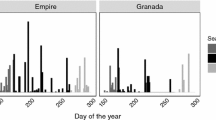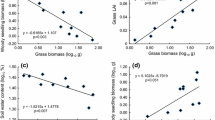Abstract
Competition for light, water and nitrogen between hazel trees and cocksfoot grown under the trees was studied in two hazel plantations managed in different ways. The first plantation with a light transmission of at least 70% at grass level was compared with two control hazel and cocksfoot monocrops. The soil was a calcareous heavy clay, 1.4 m deep. Water stress during summer was severe in the intercropped stand as well as the grass- only plots, while it was much less in the sole stand of trees (without grass). Hazel tree water potential in the intercropped stand improved in the fourth year as the trees extended their roots similarly to the grass-free ones, despite their much lower canopy growth rate. The fourth year, local N fertilisation began to be effective as evidenced by the N content per leaf area unit and growth of the intercropped trees: grass root competition was high and root barriers were needed to exclude it. The second plantation was managed on a deep soil with a water table at approximately 2.5 m depth. The trees did not suffer from the presence of grass, and allowed a 15 to 75% light transmission rate. A control monocropped grass plot was established for comparison. On the basis of the multiple limitation hypothesis, a grass dry matter production model was built which accounts for radiation transmitted to the understorey, water supply, temperature and air moisture deficit in interaction with the radiation transmission rate (r2 = 0.716; 590 observations). The limits of such models are discussed with regard to insufficient knowledge on root dynamics.
Similar content being viewed by others
References
Campbell CD, Atkinson D, Jarvis PG and Newbould P (1994) Effects of nitrogen fertiliser on tree/pasture competition during the establishment phase of a silvopastoral system. Ann appl Biol 124: 83–96
Dupraz C and Lagacherie M (1990) Cultures de feuillus précieux en vergers pâturés sur des terres agricoles du Languedoc-Roussillon: le réseau expérimental Appel. Forêt méditerranéenne 12: 447–457
Etienne M (1996) Research on temperate and tropical silvopastoral systems: a review. In: Etienne M (ed) Western European silvopastoral systems, pp 5–19. Science update, INRA éditions, Paris, France
Gleason SK and Tilman D (1992) Plant allocation and the multiple limitation hypothesis. The American Naturalist 139(6): 1322–1343
Guitton JL, De Montard FX and Rapey H (1991) Agroforesterie moderne en Auvergne. Principes et premier bilan d’une expérimentation multilocale. Informations Techniques du Cemagref 81: 2–7
Guitton JL, Dupraz C, Auclair D and De Montard FX (1994) Quel projet agroforestier pour l’Europe tempérée? Rev For Fr 46: 179–188
Jones MB (1988) Water relations. In: Jones MB and Lazenby A (ed) The grass crop: the physiological basis of production, pp 205–242. Chapman & Hall, London
Jones HG (1992) Plants and microclimate: a quantitative approach to environmental plant physiology. Cambridge University Press 428 pp
Knowles RL, Horvath GC, Carter MA and Hawke MF (1998) Developing a canopy closure model to predict overstorey/understorey relationships in Pinus radiatasilvopastoral systems. Agrofor Syst 43: 109–119
Lemaire G and Salette J (1984) Relation entre dynamique de croissance et dynamique de prélèvement d’azote pour un peuplement de graminées I–Etude de l’effet du milieu. Agronomie 4: 423–440
Ludlow MM (1980) Adaptative significance of stomatal response to water stress. In: Turner NC and Kramer PJ (ed) Adaptation of plants to water and high temperature stress, pp 123–138. Wiley, New York
Msika B (1993) Modélisation des relations herbe-arbre sous peuplements de Quercus pubescens Willd. et Pinus austriacaHöss dans les Préalpes du Sud. Thèse Ecologie Université Aix-Marseille III, 111 pp
Peacock JM (1975) Temperature and leaf growth in Lolium perenne. J Appl Ecol 12: 685–697
Qarro M and De Montard FX (1992) Etude de la productivité des parcours du Moyen Atlas 2. Modélisation de la production d’herbe: interactions climats ??sol ??recouvrement arboré. Agronomie 12: 489–501
Reynolds HL and D’Antonio C (1996) The ecological significance of plasticity in root weight ratio in response to nitrogen: opinion. Plant and Soil 185: 75–97
Robson MJ, Ryle GJ and Woledge J (1988) The grass plant–its form and function. In: Jones MB and Lazenby A (ed) The grass crop: the physiological basis of production, pp 25–83. Chapman & Hall, London
Scholander PF, Hammel HT, Bradstreet ED and Hemmingsen EA (1965) Sap pressure in vascular plants. Science 148: 338–346
Schroth G, Kolbe D, Balle P and Zech W (1996) Root system characteristics with agroforestry relevance of nine leguminous tree species and a spontaneous fallow in a semi-deciduous rainforest area of West Africa. For Ecol Manage 84: 199–208
Sibbald AR, Green SR, Hutchings NJ and Griffiths JH (1994) Silvopastoral systems in North Europe–the effect of the trees on microclimate and pasture production. In: Proceedings of the 4th International Symposium on Windbreaks and Agroforestry, pp 112–114. Viborg, Denmark, July 26–30, 1993 Hedeselskabet, Denmark
Sibbald AR (1996) Silvopastoral systems on temperate sown pastures: a personnal perspective. In: Etienne M (ed) Western European silvopastoral systems, pp 23–36. Science update, INRA éditions, Paris, France
Turc L (1961) Evaluation des besoins en eau d’irrigation, évapotranspiration Ann. Agron. 12: 13–49
Voit EO and Sands PJ (1996) Modelling Scots pine forest growth. Ecological modelling 86: 73–89
Woledge J and parsons AJ (1986) The effect of temperature on the photosynthesis of rye-grass canopies. Annals of Botany 57: 487–497
Woledge J and Leafe EL (1976) Single leaf and canopy photosynthesis in ryegrass sward. Ann Bot 40: 773–783
Author information
Authors and Affiliations
Corresponding author
Rights and permissions
About this article
Cite this article
de Montard, F.X., Rapey, H., Delpy, R. et al. Competition for light, water and nitrogen in an association of hazel (Corylus avellana L.) and cocksfoot (Dactylis glomerata L.). Agroforestry Systems 43, 135–150 (1998). https://doi.org/10.1023/A:1026475910260
Issue Date:
DOI: https://doi.org/10.1023/A:1026475910260




